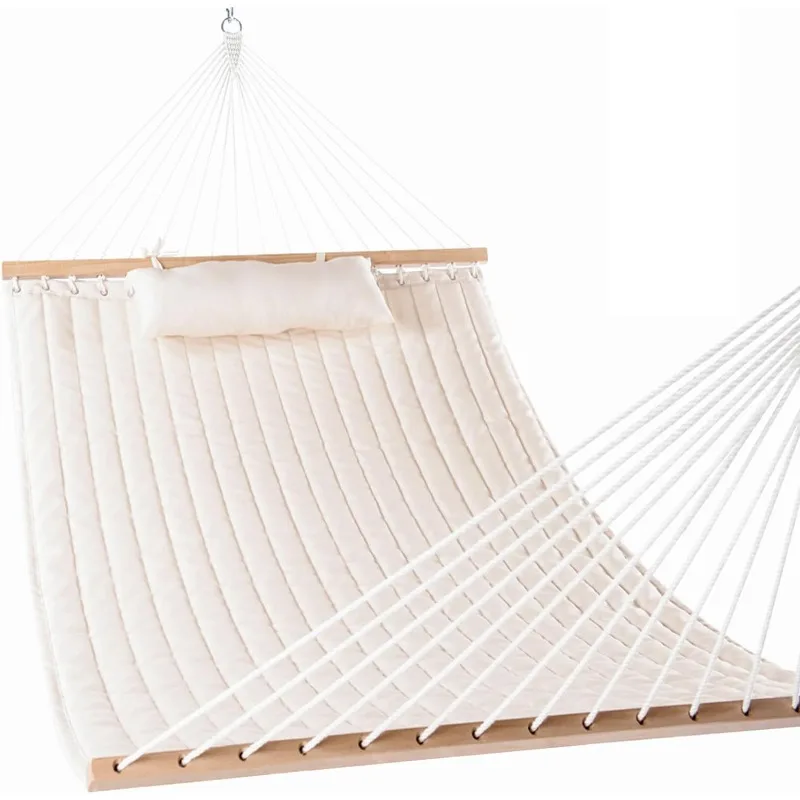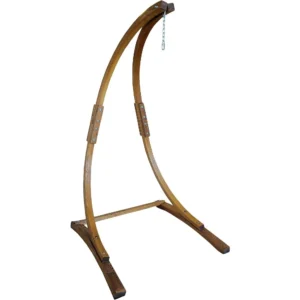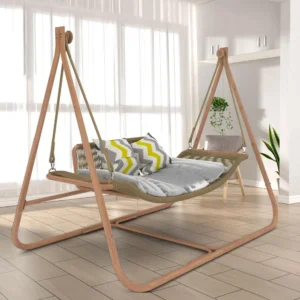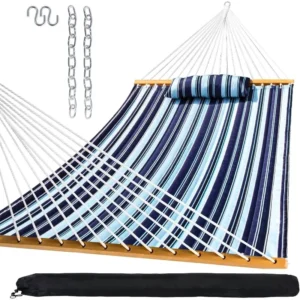What Makes Quilted Hammocks Perfect for Cozy Lounging?
Quilted hammocks represent the pinnacle of outdoor lounging comfort, setting themselves apart from standard hammocks through their distinctive layered construction. Unlike traditional rope or thin fabric options, quilted hammocks feature multiple fabric layers with soft padding sandwiched between them, creating a plush, cushioned surface that cradles your body.
The “cozy factor” of quilted hammocks comes from this specialized construction. Much like the difference between sitting on a hard wooden bench versus sinking into a well-padded cushion, quilted hammocks offer remarkable comfort through their padding. This quilting creates an experience that’s fundamentally different from lying in a single-layer hammock – the surface feels substantial, supportive, and inviting.
Key benefits that make quilted hammocks perfect for cozy lounging include:
- Superior warmth – The insulated padding creates a buffer between your body and the outside air, preventing the “cold butt syndrome” common with traditional hammocks
- Enhanced support – The quilted structure distributes weight more evenly, reducing pressure points and increasing overall comfort
- Reduced “cocooning effect” – Many quilted hammocks feature spreader bars that maintain a flatter surface, making them easier to get in and out of
- Aesthetic appeal – The substantial, plush appearance of quilted fabric hammock sets adds a touch of luxury to any space
Whether used in gardens, on patios, or indoors, quilted hammocks elevate the lounging experience with their inviting appearance and cloud-like comfort. Understanding the fundamental differences between indoor vs. outdoor hammocks can help you select the perfect option for your specific needs and environment.
Essential Materials That Make a Quality Quilted Hammock
The materials used in quilted hammocks directly influence their comfort, durability, and suitability for different environments. Knowing what goes into these hammocks helps you make an informed choice for your perfect lounging companion.
Outer Fabric Options
Polyester: This popular synthetic option offers excellent durability and weather resistance, making it ideal for outdoor use.
– Quick-drying properties prevent mildew growth
– Resistant to fading and UV damage
– Requires minimal maintenance
– Often more affordable than natural materials
Cotton: A natural fiber choice that provides unmatched softness and breathability.
– Creates a naturally soft surface against skin
– Excellent breathability for comfort in warm weather
– More susceptible to weather damage if left outdoors
– May require more frequent cleaning and maintenance
Solution-Dyed Acrylics: Premium fabrics like Sunbrella and DuraCord represent the gold standard for outdoor textiles.
– Superior UV resistance with minimal fading over many years
– Water-resistant properties that prevent mold and mildew
– Exceptional color retention even with continuous exposure
– Typically the most expensive but longest-lasting option
Olefin: An increasingly popular synthetic option known for its resilience.
– Outstanding stain resistance makes cleaning easy
– Excellent strength-to-weight ratio for durability
– Good colorfastness in outdoor conditions
– Environmentally friendly manufacturing process
Filling and Padding Materials
The interior padding is what truly defines the quilted hammock experience:
Polyester Fiberfill: The most common padding material offers a good balance of loft and support.
– Creates a cloud-like, soft surface
– Maintains shape well over time
– Available in various thicknesses for different comfort levels
– Drains and dries relatively quickly if wet
Foam Padding: Some premium models use specialized foam instead of or in addition to fiberfill.
– Provides more structured support
– Can be contoured for ergonomic benefits
– Better insulation properties for cooler weather
– May retain moisture longer than fiberfill
Construction Elements for Durability
Quality quilted hammocks incorporate several essential construction features:
- Reinforced Stitching: Double or triple stitching at stress points prevents tearing and extends lifespan
- Weather-Resistant Thread: UV-stabilized polyester thread maintains strength even with sun exposure
- Heavy-Duty Hardware: Stainless steel or powder-coated metal components prevent rust and corrosion
- Edge Reinforcement: Additional fabric layers or binding at edges prevent fraying and stretching
Understanding whether you can leave your hammock outside safely depends largely on these material choices. Premium materials might cost more initially but offer significantly better performance and longevity, especially for hammocks that will be exposed to the elements.
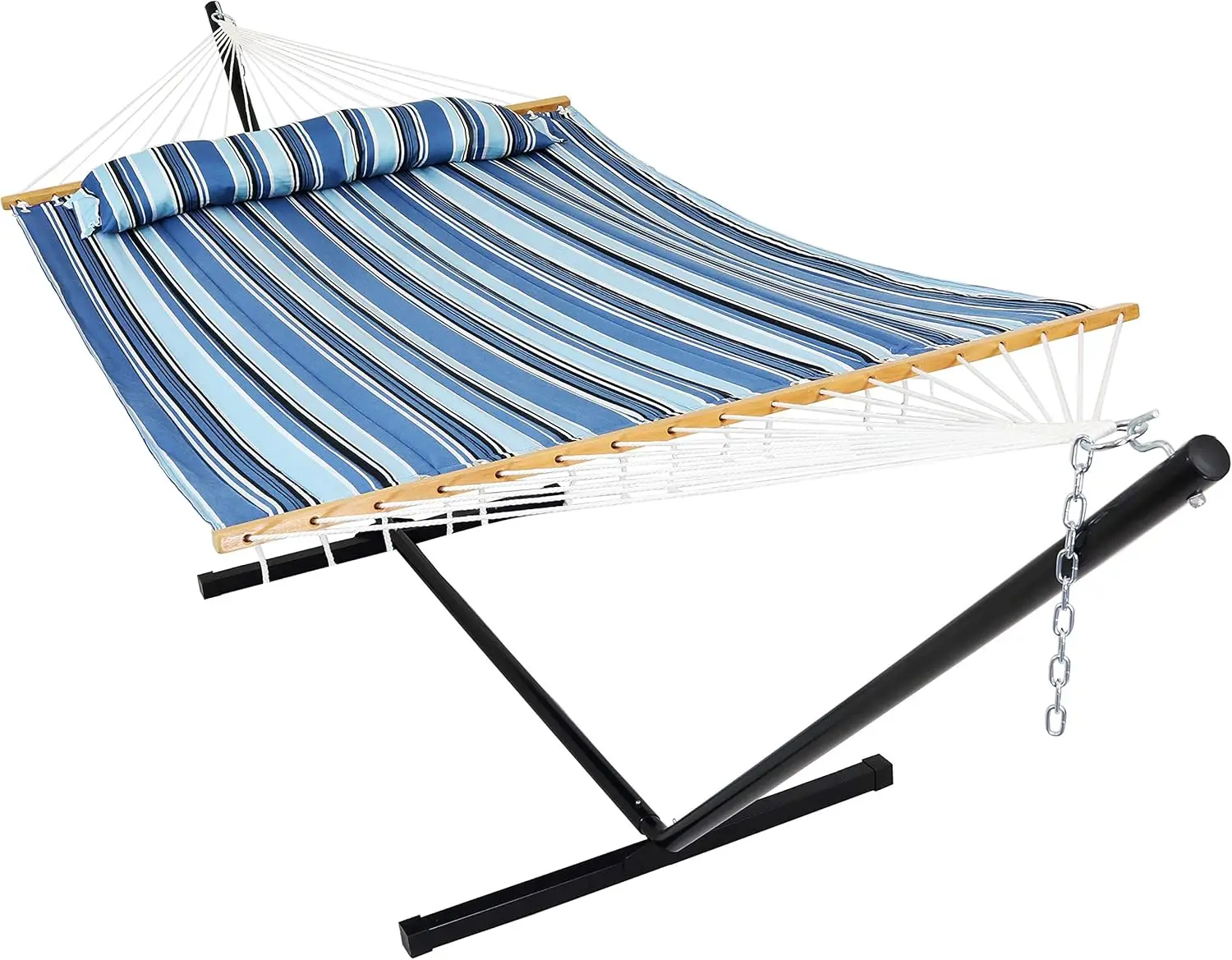
Finding Your Perfect Size: Single vs. Double Quilted Hammocks
Selecting the right size quilted hammock ensures optimal comfort and functionality for your lounging needs. The two most common options are single and double hammocks, each with distinct advantages depending on your intended use.
Size Comparison at a Glance
| Hammock Type | Typical Width | Typical Length | Weight Capacity | Best For |
|---|---|---|---|---|
| Single | 4-5 feet | 9-11 feet | 300-400 lbs | Solo loungers, smaller spaces |
| Double | 5-6.5 feet | 10-13 feet | 400-600 lbs | Couples, families, sprawlers |
| Extra-Large | 7+ feet | 12-15 feet | 500-800+ lbs | Maximum space, multiple users |
Single Quilted Hammocks
Single hammocks provide an intimate cocoon perfect for individual relaxation. With a typical width between 4-5 feet, they offer ample room for one adult to lie diagonally while maintaining a secure feeling. Their more compact size makes them ideal for:
- Limited space installations
- Balconies or small patios
- Portable setups that require easier handling
- Those who prefer a snugger, more enveloping feel
Double Quilted Hammocks
Double two-person hammock sets provide luxurious space for either solo lounging or shared experiences. With widths starting around 5 feet and extending to 6.5 feet or more, they offer significant advantages:
- Room for two adults to share comfortably
- Extra space for one person to spread out completely
- Ability to shift positions without readjusting the hammock
- Space for a parent and child to read or relax together
Measuring for Proper Fit
When selecting your hammock size, consider:
- Available space between hanging points (trees, posts, or stand)
- User needs including number of people and preferred lounging style
- Weight requirements based on anticipated maximum load (understanding hammock weight capacity guidelines is essential)
- Transport needs if you plan to move or store your hammock regularly
Common misconception: Many assume a double hammock is always more comfortable for a single person. While it does provide more room, singles are often perfectly adequate for most individuals and create a more secure feeling without excess fabric.
Must-Have Features for the Ultimate Cozy Experience
The most luxurious quilted hammocks incorporate specific design features that dramatically enhance comfort and usability. Understanding these elements helps you identify hammocks that will provide the coziest possible lounging experience.
Spreader Bars: Creating the Perfect Lounging Surface
Spreader bar hammock sets use wooden or metal bars at each end to hold the fabric flat and open. This design feature:
- Creates a more bed-like, stable surface that’s easier to enter and exit
- Reduces the “cocoon” effect that can feel claustrophobic to some users
- Allows for better air circulation around your body
- Provides better visibility of your surroundings while lounging
Quality spreader bars are typically made from hardwoods like oak or cypress for traditional appeal, or powder-coated aluminum for modern durability. The bars should feature smooth, rounded edges and secure attachments to prevent pinching or fabric wear.
Pillow and Bolster Integration
Built-in comfort features transform a simple hammock into a luxury lounging experience:
- Integrated headrests provide proper neck support for reading or conversing
- Detachable pillows allow for customizable comfort based on your preferred lounging position
- Side bolsters create a sense of security without compromising the open feel
- Lumbar cushions in premium models provide ergonomic support for longer lounging sessions
These integrated comfort elements eliminate the need to constantly adjust separate pillows that tend to slide away during use.
Convenience and Weather Features
The most thoughtful quilted hammock designs incorporate practical elements that enhance the overall experience:
- Storage pockets for books, devices, or beverages keep essentials within easy reach
- Reversible designs offer style versatility and extended use between washings
- UV-resistant fabrics maintain vibrant colors and structural integrity despite sun exposure
- Quick-dry technology allows for use shortly after rain or morning dew
- Weather-resistant hardware prevents rust and corrosion in outdoor settings
These features may seem minor individually, but collectively they create a significantly more enjoyable and hassle-free lounging experience.
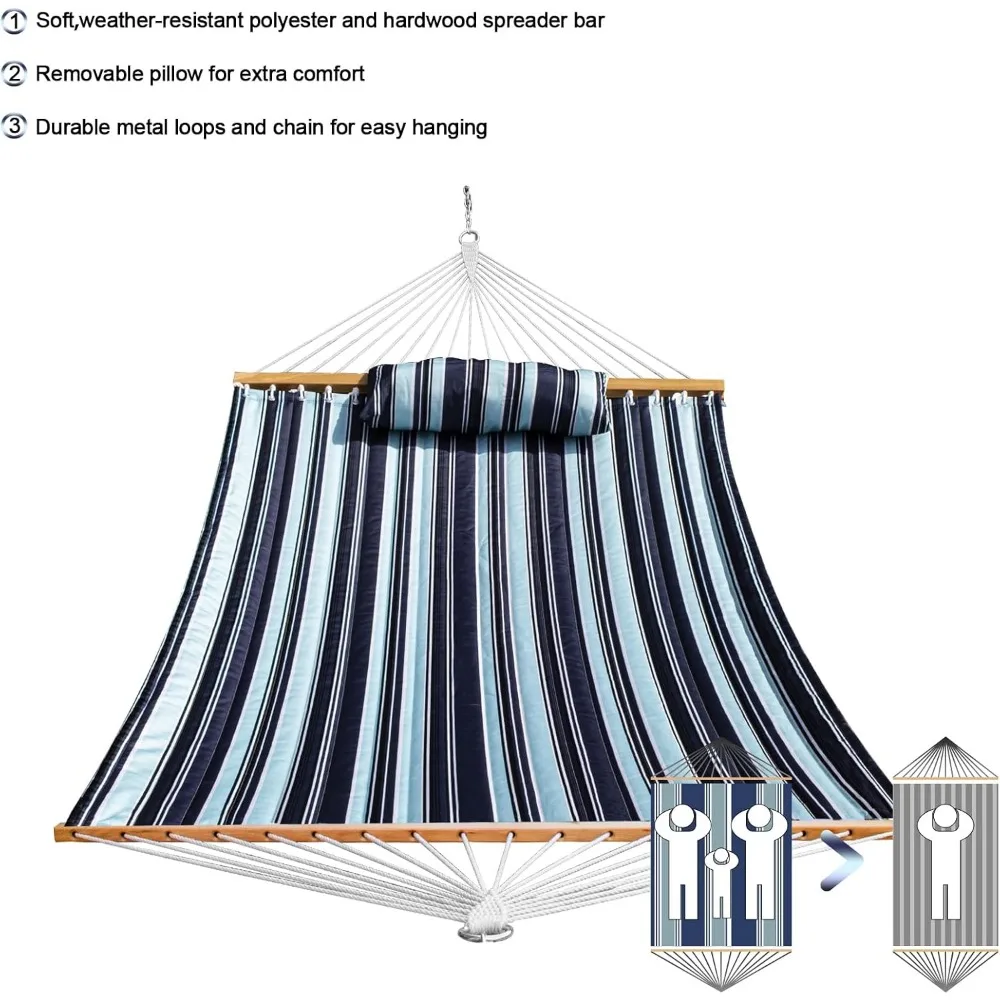
Quilted vs. Traditional Hammocks: A Comfort Comparison
Understanding how quilted hammocks compare to other styles helps clarify why they excel specifically for cozy lounging experiences. Each type offers distinct benefits depending on your priorities.
Quilted vs. Rope Hammocks
Traditional rope hammock sets feature an open-weave design that has been popular for generations, but quilted options provide several comfort advantages:
| Feature | Quilted Hammocks | Rope Hammocks |
|---|---|---|
| Surface Feel | Continuous soft fabric, no imprinting | Pattern may leave temporary marks on skin |
| Warmth | Insulated with padding for warmth | Air flows freely, cooler in warm weather |
| Weather Suitability | Good for cool to moderate temperatures | Best for hot weather |
| Comfort Duration | Comfortable for extended periods | May become uncomfortable after 1-2 hours |
| Privacy | Complete coverage | Visible through rope patterns |
The continuous surface of quilted hammocks eliminates the rope impression patterns that can become uncomfortable during longer lounging sessions. However, traditional rope designs offer superior ventilation during extremely hot weather.
Quilted vs. Non-Quilted Fabric Hammocks
Standard fabric hammock sets provide a middle ground between rope and quilted options:
| Feature | Quilted Hammocks | Non-Quilted Fabric |
|---|---|---|
| Padding | Thick cushioning throughout | No padding, single or double layer only |
| Insulation | Significant temperature regulation | Minimal insulation from elements |
| Support | More structured feel | More conforming to body |
| Weight | Heavier, less portable | Lighter, more packable |
| Price | Higher investment | Generally more affordable |
The padding in quilted hammocks creates a fundamentally different feel than non-quilted fabric options. While standard fabric hammocks conform completely to your body (like a tight hug), quilted models provide a more structured surface that feels more like a suspended bed, similar to how deep seat hammocks prioritize lounging comfort.
Quilted vs. Travel/Camping Hammocks
Lightweight travel hammocks serve a different purpose entirely:
| Feature | Quilted Hammocks | Travel/Camping Hammocks |
|---|---|---|
| Primary Purpose | Stationary comfort | Portability and function |
| Setup Location | Semi-permanent | Frequently changing |
| Comfort Priority | Maximum luxury | Adequate comfort while minimizing weight |
| Weather Resistance | Moderate to good with proper care | Excellent with minimal maintenance |
| Typical Use Duration | Hours of leisurely lounging | Overnight sleeping or brief rest |
Quilted hammocks prioritize comfort above all else, making them ideal for creating a dedicated relaxation space rather than a portable solution.
How to Choose the Perfect Quilted Hammock: Buyer’s Guide
Selecting the right quilted hammock requires considering several personal factors that will ensure your investment delivers years of cozy lounging pleasure.
Personal Assessment Checklist
Start by evaluating your specific needs and environment:
Location Considerations:
– Fully Exposed: Requires maximum weather resistance and UV protection
– Partially Covered: Moderate weather protection needed
– Indoor Use: Comfort can prioritize over weather resistance
– Multiple Locations: Portability and versatility become important factors
Understanding indoor outdoor hammock placement options will help you determine which hammock features are most important for your specific situation.
User Profile Assessment:
– Solo Lounger: Focus on personal comfort preferences
– Couples Use: Prioritize width and weight capacity
– Family Sharing: Consider durability and ease of cleaning
– Guest Use: Versatility and ease of entry/exit become more important
Climate Considerations:
– Hot Regions: Look for breathable fabrics despite the quilting
– Variable Climates: Consider reversible designs with seasonal sides
– Humid Areas: Prioritize quick-dry, mold-resistant materials
– Rainy Regions: Enhanced weather protection and drainage features
Space Evaluation:
– Measure available hanging distance carefully
– Consider stand options if permanent mounting isn’t possible
– Assess how the hammock will integrate with existing landscaping or decor
– Think about best indoor outdoor hammock locations in your specific environment
Key Questions Before Purchasing
Before finalizing your decision, ensure you have answers to these critical questions:
- Material Verification: “What specific fabrics are used in both the exterior and the filling?”
- Weight Capacity: “What is the tested weight capacity, and is it certified by an independent organization?”
- Hardware Quality: “What type of hardware is included, and is it appropriate for my intended location?”
- Warranty Coverage: “What aspects are covered under warranty and for how long?”
- Maintenance Needs: “What specific care is required to maintain appearance and structural integrity?”
- Return Policy: “What is the return window and are there any conditions I should be aware of?”
Evaluating User Reviews Effectively
When researching quilted hammocks online:
- Focus on reviews from verified purchasers
- Look specifically for comments about comfort during extended use
- Pay attention to mentions of durability over time rather than initial impressions
- Note any recurring issues mentioned by multiple reviewers
- Consider how reviewers’ usage patterns compare to your intended use
- Be wary of reviews that focus solely on delivery experience rather than product quality
Installation and Setup for Maximum Comfort and Safety
Proper installation is crucial for both the safety and comfort of your quilted hammock. Following these guidelines ensures you’ll create a secure lounging space that delivers the full cozy experience.
Secure Hanging Options
When hanging your quilted hammock between trees or posts:
- Use tree-friendly straps at least 1-2 inches wide to distribute pressure and prevent bark damage
- Maintain proper distance between hanging points—typically 2-3 feet longer than the hammock’s total length
- Install at sitting height (typically 18-24 inches from the ground when weighted)
- Aim for a 30-45 degree angle in the suspension system when weighted for optimal comfort
- Check weight limits of both the hammock and the anchor points
- Periodically inspect all connection points for wear or damage
Understanding hammock installation requirements and safety guidelines is essential before attempting setup, particularly when mounting to structures.
Hammock Stand Benefits
For maximum flexibility and ease of use, hammock stands offer significant advantages:
- No need for trees or structural mounting points
- Portability to follow sun or shade throughout the day
- Controlled height for easier entry and exit
- Consistent setup without variation in hanging distances
- Protection for trees and property
- Often include wheels for repositioning
When selecting a stand, ensure it:
– Exceeds the hammock’s rated weight capacity by at least 50 pounds
– Provides proper stability with a wide enough base
– Matches or exceeds the recommended hanging distance for your hammock
– Complements your hammock aesthetically
Is it safe to hang hammocks indoors? Absolutely, when using appropriate mounting hardware or stands specifically rated for indoor use.
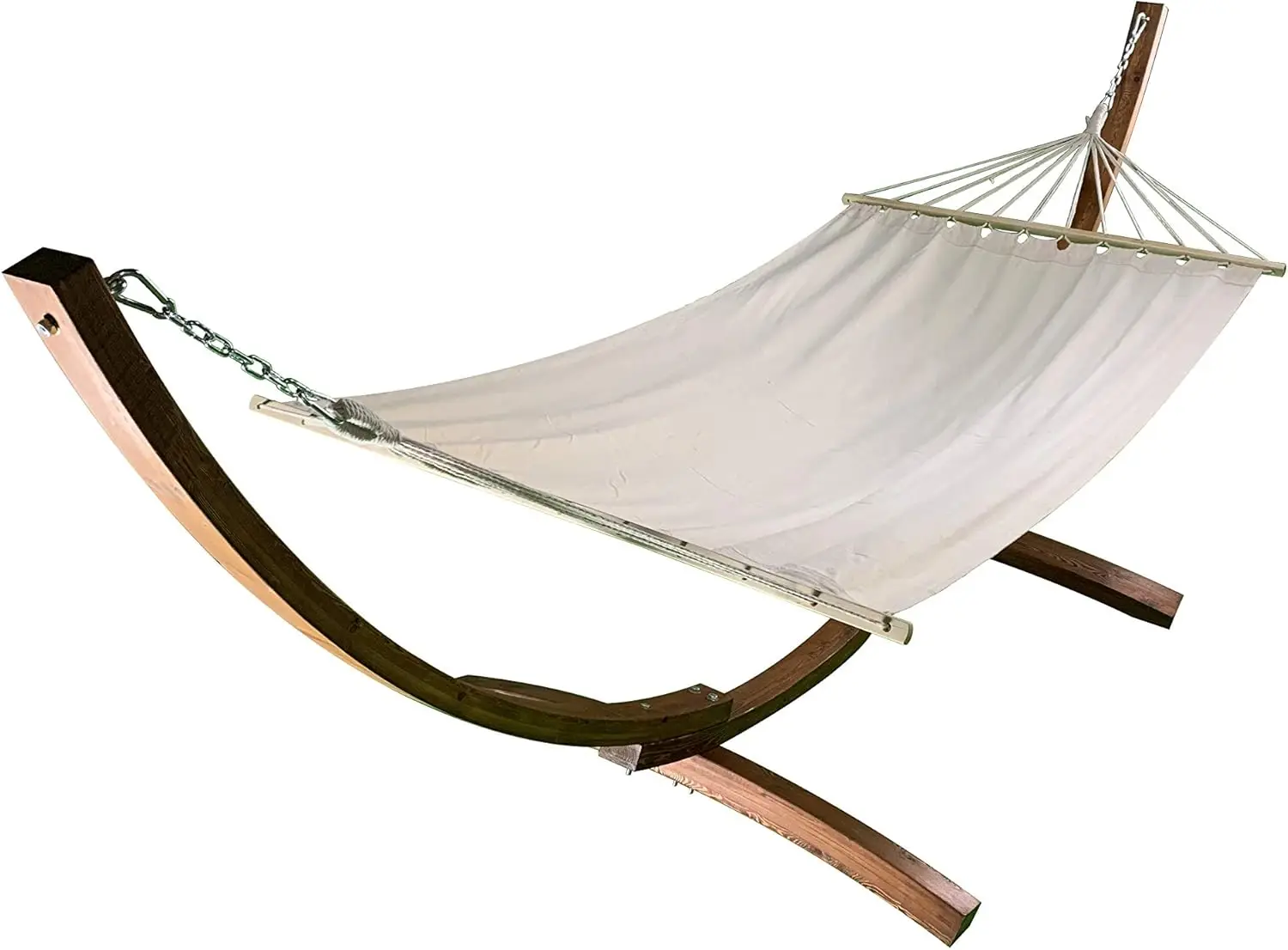
Creating the Ultimate Cozy Hammock Retreat: Accessories and Ambiance
Transforming your quilted hammock into a true relaxation sanctuary involves thoughtful accessories and environmental elements that enhance the overall experience.
Comfort-Enhancing Accessories
The right accessories can elevate your hammock from merely comfortable to absolutely luxurious:
Cushions and Pillows:
– Coordinating throw pillows in weather-resistant fabrics
– Neck roll pillows for ergonomic support
– Bolster cushions to prevent rolling or create boundaries
Temperature Regulation:
– Lightweight throws for cool evenings
– Outdoor-friendly blankets for extended season use
– Breathable cotton layers for hot days
Weather Protection:
– Waterproof covers for overnight protection
– Hammock sets with canopy for shade and light rain protection
– Wind screens to block chilly breezes
Creating Perfect Ambiance
The surroundings contribute significantly to the hammock experience:
Lighting Options:
– Solar-powered string lights for evening ambiance
– Lanterns placed at comfortable reading height
– Ground-level path lights for safety after dark
Privacy Elements:
– Potted plants as natural screens
– Decorative outdoor panels or trellises
– Strategically placed garden elements
Sensory Additions:
– Weather-resistant bluetooth speakers for gentle music
– Container gardens with fragrant plants
– Wind chimes for gentle audio ambiance
Creating the perfect hammock haven involves considering all senses and anticipating needs before they arise. Position your setup thoughtfully with attention to perfect hammock placement in home and garden principles for optimal enjoyment.
Strategic Placement Considerations
Where you place your quilted hammock dramatically affects the experience:
- Sun Exposure: Consider the sun’s path throughout the day and seasons
- Wind Patterns: Identify natural wind tunnels and protected areas
- Privacy Factors: Account for sightlines from neighbors or street views
- Convenience: Proximity to your home for beverages, bathrooms, etc.
- Natural Features: Take advantage of existing trees, gardens, or water features
- Views: Position to capitalize on the best available scenery
- Noise Sources: Avoid areas near roads, air conditioners, or other disruptions
The perfect placement balances exposure and protection, privacy and views, creating your personal outdoor sanctuary.
Maintaining Your Quilted Hammock for Years of Cozy Comfort
Proper maintenance ensures your quilted hammock remains beautiful and functional for many seasons. Different materials require specific care approaches to maintain their comfort and structural integrity.
Fabric-Specific Cleaning Techniques
Cotton Quilted Hammocks:
– Brush off loose debris regularly
– Spot clean stains promptly with mild soap and cold water
– For deeper cleaning, soak in bathtub with gentle detergent
– Always air dry completely before storage or reuse
– Consider water-repellent treatments for outdoor use
Synthetic Fabric Options:
– Hose off for regular maintenance
– Use soft brush with mild detergent for stubborn stains
– Avoid harsh chemicals that may break down UV protection
– Quick-dry in sunlight but avoid prolonged direct exposure
– Apply fabric guard seasonally for enhanced protection
Solution-Dyed Acrylics:
– Clean with diluted mild soap and soft brush
– Rinse thoroughly to prevent soap residue
– Can handle more vigorous cleaning if needed
– Most resistant to mildew but still requires drying
– Avoid bleach or abrasive cleaners
Proper Storage Methods
When your hammock needs to be stored:
- Ensure it’s completely dry to prevent mold and mildew
- Store in breathable fabric bag rather than plastic
- Choose climate-controlled location when possible
- Keep away from direct heat sources or extreme cold
- Store flat or loosely rolled rather than tightly folded
- Include cedar blocks or lavender sachets to deter pests
Preventative Care Measures
Regular maintenance prevents most common hammock issues:
- Weekly check for debris accumulation in folds
- Prompt removal of fallen leaves, pollen, or bird droppings
- Rotation of hammock orientation to prevent uneven UV exposure
- Seasonal deep cleaning regardless of apparent need
- Hardware inspection for early signs of rust or wear
- Immediate attention to small tears or loose threads
Following indoor outdoor hammock safety guidelines not only enhances safety but also extends the life of your hammock through proper use and care.
Top-Quality Quilted Hammocks for Every Setting and Style
When selecting a premium quilted hammock, consider both your environment and personal preferences. The market offers specialized options for various needs and aesthetic preferences.
Best for Outdoor Durability
For locations with challenging weather or constant exposure, focus on these features:
- Solution-dyed acrylic fabrics with 5+ year UV warranties
- Marine-grade hardware with corrosion resistance
- Double-reinforced attachment points
- Water-resistant inner batting
- Weather-resistant wood or powder-coated metal components
These hammocks may cost more initially but will deliver significantly longer lifespans in demanding outdoor environments.
Most Luxurious Comfort Options
For the ultimate in cozy lounging, look for these premium features:
- Thick, multi-layer quilting with graduated densities
- Integrated ergonomic support features
- Multiple-position adjustable spreader bars
- Hand-finished detailing and reinforcement
- Extra-wide designs for unrestricted lounging
- Wooden hammock stands that add visual warmth and stability
Dark Wood Hammock Sets, Porch Swing Chair Sets
$653.82 Select options This product has multiple variants. The options may be chosen on the product pageA-Frame Stand Hammock Sets, Swinging Hammock Chair Sets
$154.62 Select options This product has multiple variants. The options may be chosen on the product pageLight Wood Hammock Sets, Swinging Hammock Chair Sets
$1,359.35 Select options This product has multiple variants. The options may be chosen on the product pageClassic Wooden Stand Hammock Sets, Heavy Duty Hammock Sets
$1,061.68 Select options This product has multiple variants. The options may be chosen on the product pageHammock Sets with Canopy, Heavy Duty Hammock Sets
$286.31 Select options This product has multiple variants. The options may be chosen on the product page
Best Value Without Compromising Quality
Quality quilted hammocks represent a significant investment, but these features indicate good value:
- Polyester/cotton blended fabrics for durability with comfort
- Standard (rather than premium) hardware that’s still corrosion-resistant
- Simplified spreader bar designs that maintain function
- Machine-washable construction for easy maintenance
- Included basic accessories like hanging hardware
- Warranty coverage of at least 1 year
For those needing substantial support, heavy duty hammock sets provide robust construction with reinforced stitching and higher weight capacities without unnecessary premium features.
Most Versatile Designs
Some quilted hammocks excel at adaptability between different settings and seasons:
- Reversible designs with different patterns/colors on each side
- Modular components that can be added or removed
- Adjustable features for different lounging positions
- Weather-resistant materials that can transition indoors when needed
- Portable stands that disassemble for storage or transport
These adaptable designs provide maximum utility across changing needs and environments.
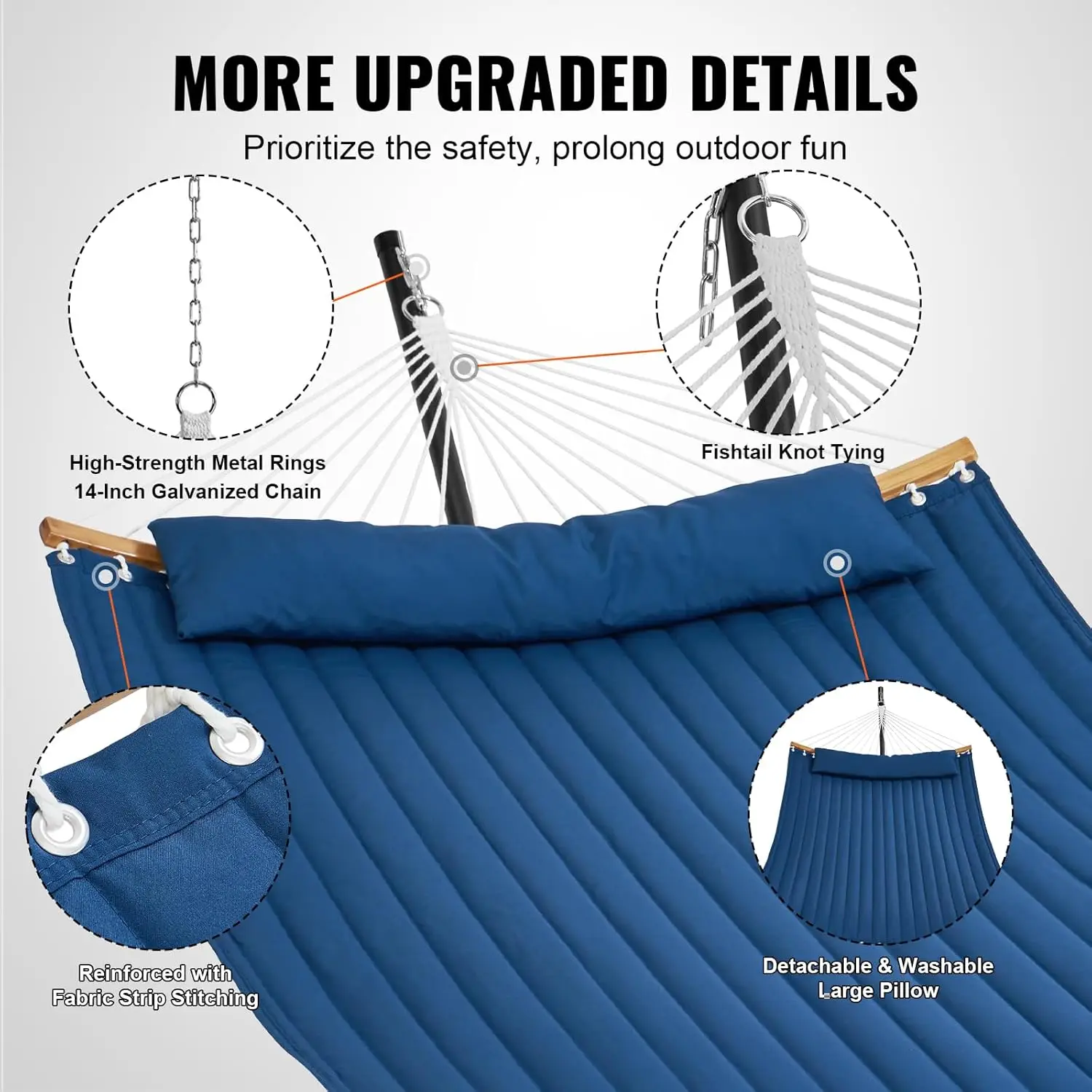
Common Questions About Quilted Hammocks
Are quilted hammocks suitable for overnight sleeping?
While quilted hammocks can be comfortable for naps or occasional overnight sleeping, they’re primarily designed for lounging rather than full-night sleep. Their structured surface doesn’t conform to the body in the same way as camping hammocks designed specifically for sleeping. However, their padded construction does make them more comfortable for extended rest than traditional rope or thin fabric hammocks.
What is the typical weight capacity of a double quilted hammock?
Double quilted hammocks typically support between 400-600 pounds, depending on construction quality and materials. Premium models from brands like Outside Luxe often feature reinforced stitching and heavy-duty hardware that can safely support weights at the upper end of this range. Always check the manufacturer’s specific weight rating and allow for a safety margin.
Can quilted hammocks be safely left outdoors year-round?
Even the most weather-resistant quilted hammocks will last significantly longer if protected during harsh weather. While premium models with solution-dyed acrylic fabrics can withstand considerable exposure, continual protection from precipitation, freezing temperatures, and intense sun will extend their lifespan. Consider using a weather cover or storing the hammock during extreme conditions or extended periods of non-use.
How do quilted hammocks perform in very hot or humid weather?
The padding in quilted hammocks provides excellent insulation, which can be both an advantage and disadvantage depending on the temperature. In hot, humid conditions, this insulation may retain heat and moisture against the body. Look for quilted hammocks with breathable cotton blends or specialized quick-dry synthetic materials if you’ll primarily use it in hot weather. Some users find rotating the hammock periodically during use helps maintain comfort.
What are the best methods to prevent a spreader bar hammock from tipping?
To minimize tipping in spreader bar hammocks:
– Enter by sitting in the center and then pivoting legs up
– Keep your weight centered along the middle axis
– Avoid sudden movements or shifting to one side
– Ensure proper installation height (typically 18-24 inches from ground)
– Use a wider hammock that provides more stability
– Consider stands designed specifically for spreader bar stability
How do I safely get in and out of a quilted hammock?
The safest entry method is:
1. Back up to the hammock’s center until you feel it against the back of your legs
2. Reach back and hold both sides with your hands for stability
3. Slowly sit down in the center (not on the edge)
4. Gently swing your legs up while maintaining centered weight
5. For exit, reverse the process by sitting up first, then placing feet on the ground
Finding best places to hang hammocks indoors with adequate clearance helps ensure safe entry and exit.
How long should a quality quilted hammock last with proper care?
With appropriate maintenance, premium quilted hammocks can last 7-10 years or more. Factors affecting longevity include:
– Exposure to elements (particularly UV radiation)
– Frequency of use
– Adherence to weight limitations
– Regular cleaning and proper storage
– Quality of initial materials and construction
Lower-quality options might need replacement after 2-3 years of regular use, while top-tier products from reputable manufacturers like Outside Luxe often maintain their structural integrity and appearance much longer.
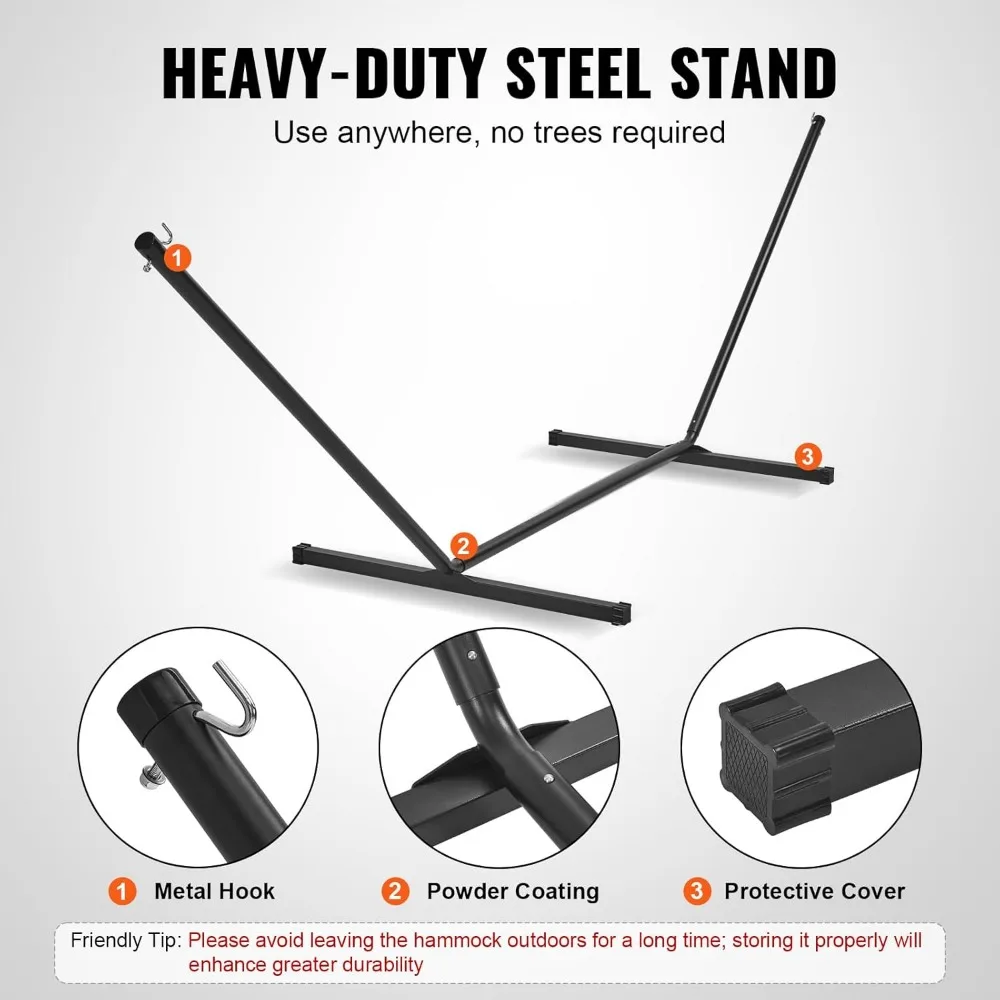
Can quilted hammocks be used in winter conditions?
Quilted hammocks can extend your outdoor season into cooler weather due to their insulated construction, but they’re not designed for true winter use in freezing conditions. For cooler (but not freezing) weather:
– Add warm blankets above and below your body
– Position in full sun during daylight hours
– Use a wind barrier if possible
– Consider quick trips indoors to warm the hammock with a blanket from a dryer
– Limit exposure to moisture which can create uncomfortable cold spots
The padding in quilted hammocks provides significant insulation compared to other styles, making them the best choice for comfortable use in cooler transitional seasons.

